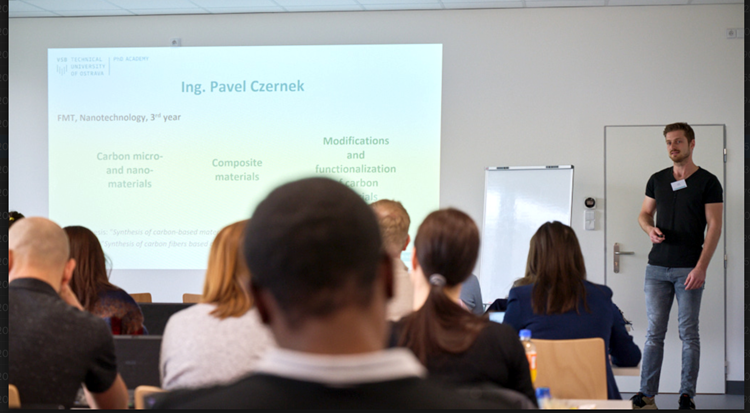Learn something new every day
Pavel deals with nanotechnologies with a focus on the chemistry of composite materials, publishes, works on research projects, is the author of a patent. How did he get into chemistry and what motivated him to enter the competition? He answered in an interview.
The City of Ostrava at the beginning of February published the results of the Talent of the Year competition, where you succeeded in the category of doctoral studies. What does this mean for you?
I take it as a shift in my professional career. But it's not only my success, it's also the success of the Centre of Nanotechnologies CEET VŠB-TUO, the laboratory of advanced nanomaterials, my supervisor, Professor Daniela Plaché and other colleagues from the Faculty of Materials and Technology and the Faculty of Mechanical Engineering who work with us. It's a proof that the topics we work on make sense.
What motivated you to enter the competition?
It is a prestigious award of the city of Ostrava for talented students, which I learned about just before the beginning of my doctoral studies. So I started working on having something to show in my final year and to compete for this award, which finally came out :).

I mentioned that you succeeded in the category of doctoral studies. What are you focusing on in your dissertation? I know that you are dedicated to nanotechnology, but after all, it is a broad concept.
It is. Nanotechnology is a fairly broad concept, in our country we divide it into physics and chemistry. I am devoted to chemistry, especially chemistry of composite materials that are reinforced with carbon fibres. These are structural materials that have found use in, for example, the transport, energy or sports industries. In my work I focus on synthesis of cheap carbon fibres, because the current ones are very expensive, which limits the use of such composite materials. Cheap, but at the same time sufficient carbon fibers, could find application, for example, in lightening passenger cars, which can reduce the weight of a vehicle by up to 30%, and thus its consumption and, as a result, the emission of greenhouse gases. At the beginning of the doctorate there was only the idea of how to synthesize cheap, and at the same time sufficiently strong, carbon fibers. We did not have the proper equipment, so during my doctoral thesis I used my knowledge from mechanical engineering and, with the help of my colleagues, assembled a fibreglass apparatus with a winding device that can fiber raw carbon fibers. But there is still work to be done. In addition, in my work I also deal with improving the mechanical properties of composite materials reinforced with carbon fibers by adding other additives.
And this, what you have in your hand, is specifically for cars?
Yes. These are test samples. It is these materials that are used for cars and can replace steel or aluminum structures. Our test materials are straight, but they can be shaped in different ways in the manufacturing process.
What is your fascination with the field of nanotechnology?
My path to nanotechnology was quite complex. In elementary school, like any student, I went through chemistry. I liked it, but I didn't enjoy learning, I didn't see the point. So my friends and I did various experiments according to the instructions on the Internet, like smoke bombs or gunpowder. That was probably the beginning. To study in high school, I chose engineering, where I had chemistry for about six months. And in college, specifically in the Faculty of Security Engineering, I studied technical safety of persons and property. Chemistry, which was there, I gave a 51 and didn't care. But over time, I found that I was better than that and became interested in nanotechnology, which had fascinated me with its name before. They helped me at the Career Center, which offered an optional Start-up Business course, and it was here that I was finally connected with Professor Placha. I did my thesis under her guidance and spent a lot of time self-studying chemistry. In my thesis, I devoted myself to carbon materials and their use in ballistic-resistant materials.
Your thesis sounds interesting. Can you elaborate on that?
I studied articles and read a few books that dealt with carbon materials and current trends in ballistic protection to get a little insight. Currently, dilatant liquids based on silica nanoparticles and polyethylene glycol are being tested and applied to the Kevlar fabrics of ballistic vests. The silica nanoparticles are then held on a Kevlar vest and in case of impact of a projectile or a stabbing weapon, kinetic energy dispersion is improved by more friction between the strands where the nanoparticles are held. I wanted to use extra-solid carbon tubes instead of silica nanoparticles, but they were not produced, although I followed the instructions exactly. I did not finish my thesis as I expected, but it motivated me to continue my research efforts. Later, we found out that dilettante fluids weren't all that great, and we dropped out. However, ballistically resistant materials are a hot topic of conflict at the moment, and I have an idea, so we'll see after my dissertation is finished.
Was it hard to get into nanotechnology from the FBI and learn that chemistry?
Admission to nanotechnology was not a problem. At the Nanotechnology Center, I was already working on my thesis, and I was already known to be passionate about the subject, and I learned some of the basics of chemistry. The first two years were the hardest. I was always learning something new, from basic organic synthesis to the synthesis of carbon materials from the gaseous phase.
In addition to the above, you also publish, work on research projects, and are the author of a patent. What patent?
Yes, I'm the co-author of the patent. We have it filed with Professor Placha and colleague Petr Langro. The patent concerns micrometer resin balls that can extract boron (an element) from water sources. As an example, I can cite seawater. Currently, the trend is to desalinate seawater, but even so, you cannot use it, even if you remove the salt from it. Seawater contains an upper limit amount of boron, which is dangerous for the human body and any living organisms.
Did you always want to be a scientist, or did you come to it gradually?
I wanted to be an entrepreneur. Maybe there will be a spin-off. We'll see.
Did you have a small dream about your profession? What did you want to be?
Maybe a chef, that is quite close to chemistry, only the raw materials you use are different.
Why did you choose VSB – Technical University of Ostrava for your studies?
I have studied here since my bachelor's studies. I didn't want to go anywhere and I like Ostrava. I am a Moravian-Silesian patriot, I come from Třinec. I decided to VŠB-TUO also because I wasn't the best student, I had to grow up.
What advice would you give to students who are thinking about, say, doctoral studies, participating in competitions and the like?
Every day try to learn something new. Any small step can move you forward. Work on yourself.
